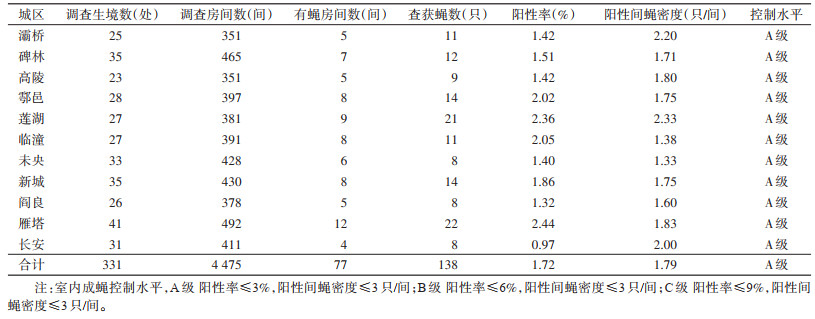扩展功能
文章信息
- 李广帅, 徐琨, 雷晓岗, 薛威, 金梁栋, 解民, 杨西平, 庞松涛
- LI Guang-shuai, XU Kun, LEI Xiao-gang, XUE Wei, JIN Liang-dong, XIE Min, YANG Xi-ping, PANG Song-tao
- 西安市2022年城区蝇类侵害水平的调查
- An investigation of fly infestation level in urban Xi'an, China, 2022
- 中国媒介生物学及控制杂志, 2023, 34(6): 809-813
- Chin J Vector Biol & Control, 2023, 34(6): 809-813
- 10.11853/j.issn.1003.8280.2023.06.019
-
文章历史
- 收稿日期: 2023-06-01
蝇类是常见的病媒生物,除骚扰人们生活外,还携带、传播细菌、病毒等致病微生物[1-2]。由于夏、秋季蝇密度高、活动频繁,传播肠道传染病风险高,严重危害人群健康[3],一直是各地夏秋季重点防治的病媒生物。2022年9月作者在西安市开展了蝇类侵害情况调查,了解各城区蝇类防制工作情况,也为科学制定蝇类防制措施提供依据。
1 材料与方法 1.1 调查范围按照《病媒生物密度控制水平蝇类》(GB/T 27772-2011)的要求,在西安市11个市辖区的不同方位随机抽取调查生境,分为室内环境和外环境。
1.2 调查方法按照《病媒生物密度监测方法蝇类》(GB/T 23796-2009)的规定,采用目测法进行调查并计算蝇类侵害指标。
室内成蝇密度计算公式如下:

|
室外蝇类孳生阳性率计算公式如下:

|
防蝇设施合格率计算公式如下:

|
将调查数据录入WPS 14309表格中,建立数据库,计算室内有蝇房间阳性率、阳性间蝇密度以及室外蝇类孳生阳性率、防蝇设施合格率等蝇类侵害指标,进行描述性分析。
1.4 结果评价按照《病媒生物密度控制水平蝇类》(GB/T 27772-2011)要求的标准对全市各城区蝇类侵害情况开展评价。
2 结果 2.1 成蝇侵害情况在西安市11个市辖区共抽取8种331处生境,折合共计4 475间标准房间,77间标准间发现蝇类138只,有蝇房间阳性率为1.72%,阳性间蝇密度为1.79只/间,控制水平为A级。成蝇侵害情况最严重的生境是农贸市场,有蝇房间阳性率为2.48%;成蝇侵害情况最严重的城区是雁塔区,为2.44%。见表 1、2。

|
共调查外环境中722处孳生地,发现3处阳性孳生地,阳性率为0.42%,控制水平为A级。阳性孳生地只存在于外环境散在孳生地中,分布在鄠邑、莲湖和未央区,控制水平均为B级。见表 3、4。
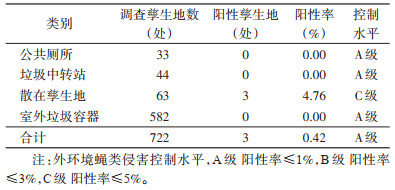
|
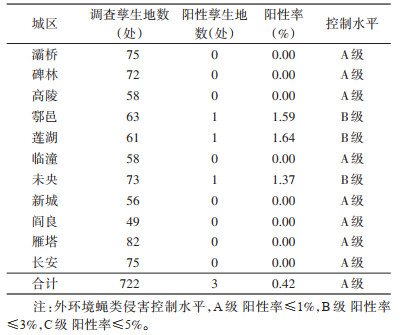
|
共调查331处生境2 161处防蝇设施的设置情况,2 084处防蝇设施设置合格,合格率为96.44%,为B级水平。各生境中农贸市场的合格率最低,为92.53%,各城区中灞桥区的合格率较低,为94.63%。见表 5、6。
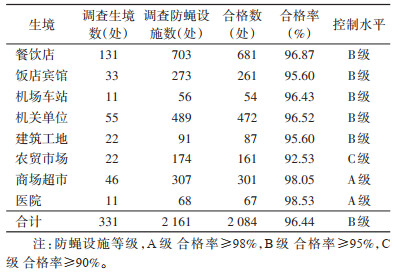
|
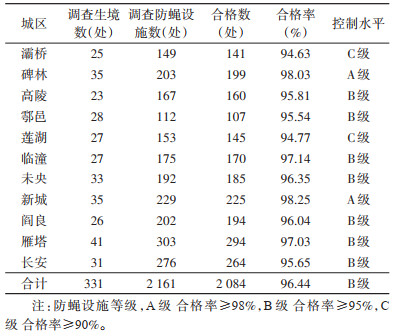
|
共调查224处生产销售直接入口食品的生境,均未发现有蝇及蝇类孳生地。按照《病媒生物密度控制水平蝇类》(GB/T 27772-2011)的标准,全市城区蝇类侵害控制水平为B级。
3 讨论调查发现,2022年西安市室内蝇密度控制水平为A级,优于北京和石家庄市的控制水平[4-5],但低于浙江省海宁市[6],和本市2019年相比,有一定进步[7]。农贸市场有蝇房间阳性率较高,但较2019年有了很大的改善。2021年西安市举办全国运动会,政府对全市基础设施进行了改造整治,也减少了蝇类的孳生和侵害。各城区控制水平均较好,雁塔、莲湖区有很多旅游景点和城中村,小餐馆多,大量不能及时处理的厨余垃圾容易导致蝇类孳生,虽然较2019年有了很大的改善[7],但相对其他生境仍较为严重,陶卉英等[8]调查也发现小餐馆是蝇类危害的高风险生境。应加强小餐馆的监督检查,规范厨余垃圾处理和封闭,减少蝇类孳生和对蝇类的吸引,进而降低传染病疫情的风险[8]。
本次外环境调查发现,散在孳生地中有蝇类孳生,但阳性率低于武汉市和泸州市[9-10],相比2019年有了很大的进步[7],防蝇设施合格情况和2019年基本一致[7]。通过对本市近几年的调查研究以及结合其他研究者的调查结果,发现创建国家卫生城市、举办重大活动对市政基础设施进行改造整治,改善了整个社会的环境卫生[11-13],同时也减少了蝇类等病媒生物的侵害[8]。
在政府、专家学者等社会各界的努力下,我国蝇类等病媒生物防制取得了较好的成绩[14],随之也出现了病媒生物耐药的新挑战[15],随着社会经济进步,病媒生物防制也出现了新的需求[16-17]。面对新形势和新问题,很多研究者也都进行了探索[18-19],提出了很多应对措施,比如加强宣传、提高认识[20]、政府加大投入、引入社会专业机构等[21]。总之,只有采取全社会参与的综合防制措施,才能取得良好而持久的蝇类防制效果。
利益冲突 无
| [1] |
程晓兰, 王光, 陈雪松, 等. 2006-2015年辽宁口岸蚊、蝇种群结构及其携带病原体监测检测[J]. 中国国境卫生检疫杂志, 2016, 39(6): 385-391. Cheng XL, Wang G, Chen XS, et al. Analysis on population structure and pathogens detection of mosquitoes and flies at Liaoning ports from 2006 to 2015[J]. Chin Front Health Quar, 2016, 39(6): 385-391. DOI:10.16408/j.1004-9770.2016.06.002 |
| [2] |
曹晓梅, 宋锋林, 姚李四, 等. 口岸蝇类携带致病菌及寄生虫卵的检测分析[J]. 中华卫生杀虫药械, 2016, 22(2): 148-152. Cao XM, Song FL, Yao LS, et al. Detection of fly-borne pathogenic bacteria and parasite eggs collected from ports[J]. Chin J Hyg Insect Equip, 2016, 22(2): 148-152. DOI:10.19821/j.1671-2781.2016.02.014 |
| [3] |
王雪霜, 吴海霞, 刘起勇. 2019年全国蝇类监测报告[J]. 中国媒介生物学及控制杂志, 2020, 31(4): 407-411. Wang XS, Wu HX, Liu QY. National surveillance report on flies in China, 2019[J]. Chin J Vector Biol Control, 2020, 31(4): 407-411. DOI:10.11853/j.issn.1003.8280.2020.04.005 |
| [4] |
赵岩, 侯威远, 王磊. 北京市海淀区病媒生物侵害状况调查[J]. 中华卫生杀虫药械, 2019, 25(1): 29-33. Zhao Y, Hou WY, Wang L. An investigation on the situation of vector infestation in Haidian district of Beijing[J]. Chin J Hyg Insect Equip, 2019, 25(1): 29-33. DOI:10.19821/j.1671-2781.2019.01.009 |
| [5] |
翟士勇, 逯春梅. 石家庄市主城区2016年病媒生物侵害状况调查[J]. 中国媒介生物学及控制杂志, 2018, 29(1): 111. Zhai SY, Lu CM. Investigation on vectors of main urban areas in Shijiazhuang city, 2016[J]. Chin J Vector Biol Control, 2018, 29(1): 111. DOI:10.11853/j.issn.1003.8280.2018.01.030 |
| [6] |
葛宗良, 凌锋, 丁丰, 等. 2015年海宁市城区病媒生物密度监测评估分析[J]. 中国农村卫生事业管理, 2017, 37(5): 549-552. Ge ZL, Ling F, Ding F, et al. Monitoring and evaluation of vectors from 2015 in Haining city[J]. Chin Rural Health Serv Adm, 2017, 37(5): 549-552. |
| [7] |
李广帅, 庞松涛, 雷晓岗, 等. 2019年夏季西安市城镇蝇类侵害状况调查[J]. 热带医学杂志, 2021, 21(12): 1605-1608. Li GS, Pang ST, Lei XG, et al. Investigation on fly infestation of urban areas of Xi'an in summer of 2019[J]. J Trop Med, 2021, 21(12): 1605-1608. DOI:10.3969/j.issn.1672-3619.2021.12.024 |
| [8] |
陶卉英, 柳小青, 马红梅, 等. 南昌市重点行业蝇类危害风险评估[J]. 中国媒介生物学及控制杂志, 2015, 26(5): 491-494. Tao HY, Liu XQ, Ma HM, et al. Risk assessment and control of flies in major industries of Nanchang city[J]. Chin J Vector Biol Control, 2015, 26(5): 491-494. DOI:10.11853/j.issn.1003.4692.2015.05.015 |
| [9] |
周良才, 包继永, 吴丽群, 等. 武汉市2016年不同环境蝇类孳生现况调查[J]. 中国媒介生物学及控制杂志, 2018, 29(6): 645-647. Zhou LC, Bao JY, Wu LQ, et al. Investigation of breeding situation of flies in different environments in Wuhan, 2016[J]. Chin J Vector Biol Control, 2018, 29(6): 645-647. DOI:10.11853/j.issn.1003.8280.2018.06.025 |
| [10] |
李劲松. 泸州市三区病媒生物孳生地调查[J]. 中华卫生杀虫药械, 2015, 21(4): 401-403. Li JS. A survey of breeding grounds for medical vectors in Luzhou city[J]. Chin J Hyg Insect Equip, 2015, 21(4): 401-403. DOI:10.19821/j.1671-2781.2015.04.025 |
| [11] |
程时秀, 龚丽丽, 吕均, 等. 湖北省十堰市创建国家卫生城市前后病媒生物密度监测与分析[J]. 医学动物防制, 2019, 35(10): 1009-1011. Cheng SX, Gong LL, Lyu J, et al. Surveillance and analysis of vector density before and after the establishment of national health city in Shiyan city, Hubei province[J]. J Med Pest Control, 2019, 35(10): 1009-1011. DOI:10.7629/yxdwfz201910026 |
| [12] |
陈祖华, 李晓军, 黄进, 等. 攀枝花市病媒生物预防控制效果评估分析[J]. 中华卫生杀虫药械, 2019, 25(4): 346-350. Chen ZH, Li XJ, Huang J, et al. Effect evaluation on integrated vector control in Panzhihua city[J]. Chin J Hyg Insect Equip, 2019, 25(4): 346-350. DOI:10.19821/j.1671-2781.2019.04.013 |
| [13] |
张学太, 吴嘉徽. 甘肃省白银市国家卫生城市创建对病媒生物防制影响分析[J]. 中国媒介生物学及控制杂志, 2022, 33(5): 715-721. Zhang XT, Wu JH. An analysis of influence of National Sanitary city construction on vector control in Baiyin, Gansu province, China[J]. Chin J Vector Biol Control, 2022, 33(5): 715-721. DOI:10.11853/j.issn.1003.8280.2022.05.019 |
| [14] |
冷培恩, 刘洪霞, 吴寰宇, 等. 上海市病媒生物控制30年回顾[J]. 上海预防医学, 2019, 31(2): 125-133. Leng PE, Liu HX, Wu HY, et al. Thirty-year review of vector control in Shanghai[J]. Shanghai J Prev Med, 2019, 31(2): 125-133. DOI:10.19428/j.cnki.sjpm.2019.18999 |
| [15] |
亓云鹏, 富小飞, 查亦薇, 等. 浙江省嘉兴市主要病媒生物对常用卫生杀虫剂的抗药性调查[J]. 中国媒介生物学及控制杂志, 2019, 30(3): 337-340. Qi YP, Fu XF, Zha YW, et al. Study on resistance of main vectors to commonly used insecticides in Jiaxing, China[J]. Chin J Vector Biol Control, 2019, 30(3): 337-340. DOI:10.11853/j.issn.1003.8280.2019.03.026 |
| [16] |
马先富, 蔡一华, 王建勋, 等. G20杭州峰会病媒生物防制保障实践和启示[J]. 中国媒介生物学及控制杂志, 2019, 30(2): 185-190. Ma XF, Cai YH, Wang JX, et al. Practice of vector control during the G20 Hangzhou Summit and its enlightenment[J]. Chin J Vector Biol Control, 2019, 30(2): 185-190. DOI:10.11853/j.issn.1003.8280.2019.01.016 |
| [17] |
刘起勇. 新时代媒介生物传染病形势及防控对策[J]. 中国媒介生物学及控制杂志, 2019, 30(1): 1-6, 11. Liu QY. Epidemic profile of vector-borne diseases and vector control strategies in the new era[J]. Chin J Vector Biol Control, 2019, 30(1): 1-6, 11. DOI:10.11853/j.issn.1003.8280.2019.01.001 |
| [18] |
吴太平, 陈晓敏, 梁建生, 等. 用病媒生物问题清单推动城市病媒生物防治的探索[J]. 中华卫生杀虫药械, 2020, 26(4): 306-310. Wu TP, Chen XM, Liang JS, et al. The exploration on promoting urban vector management by using vector spot checklist[J]. Chin J Hyg Insect Equip, 2020, 26(4): 306-310. DOI:10.19821/j.1671-2781.2020.04.002 |
| [19] |
赵奇, 武文, 黄华. 病媒生物预防控制"四早"策略分析[J]. 中国媒介生物学及控制杂志, 2021, 32(2): 254-256. Zhao Q, Wu W, Huang H. The strategies of "early detection, early report, early assessment, and early control" in vector prevention and control[J]. Chin J Vector Biol Control, 2021, 32(2): 254-256. DOI:10.11853/j.issn.1003.8280.2021.02.027 |
| [20] |
龚震宇, 张新卫, 侯娟, 等. 浙江省病媒生物防制工作实践、存在的问题及对策建议[J]. 中国媒介生物学及控制杂志, 2020, 31(2): 121-125. Gong ZY, Zhang XW, Hou J, et al. Practice, deficiencies, and countermeasures of vector control in Zhejiang province, China[J]. Chin J Vector Biol Control, 2020, 31(2): 121-125. DOI:10.11853/j.issn.1003.8280.2020.02.001 |
| [21] |
李晓宁, 刘远, 陈宗遒, 等. 政府购买病媒生物防制服务防控登革热疫情的效果评价[J]. 中国媒介生物学及控制杂志, 2020, 31(3): 259-262. Li XN, Liu Y, Chen ZQ, et al. Effectiveness evaluation of government-purchased vector control services for the prevention and control of dengue fever[J]. Chin J Vector Biol Control, 2020, 31(3): 259-262. DOI:10.11853/j.issn.1003.8280.2020.03.003 |
| [22] |
Cai WJ, Zhang C, Suen HP, et al. The 2020 China report of the Lancet Countdown on health and climate change[J]. Lancet Public Health, 2021, 6(1): e64-e81. DOI:10.1016/S2468-2667(20)30256-5 |
| [23] |
Liu HM, Liu LH, Cheng P, et al. Bionomics and insecticide resistance of Aedes albopictus in Shandong, a high latitude and high-risk dengue transmission area in China[J]. Parasit Vectors, 2020, 13(1): 11. DOI:10.1186/s13071-020-3880-2 |
| [24] |
谢博, 冯磊, 顾盈培, 等. 气候因素对浦东新区蚊虫密度影响的效应分析[J]. 中国媒介生物学及控制杂志, 2019, 30(4): 430-433. Xie B, Feng L, Gu YP, et al. An analysis of the effect of climatic factors on mosquito density in Pudong New Area, Shanghai, China[J]. Chin J Vector Biol Control, 2019, 30(4): 430-433. DOI:10.11853/j.issn.1003.8280.2019.04.017 |
| [25] |
徐苗苗, 苏通, 刘莹莹, 等. 石家庄市2017-2019年气象因素与手足口病发病相关性及其滞后效应分析[J]. 中华流行病学杂志, 2021, 42(5): 827-832. Xu MM, Su T, Liu YY, et al. Analysis on influence and lag effects of meteorological factors on incidence of hand, foot and mouth disease in Shijiazhuang, 2017-2019[J]. Chin J Epidemiol, 2021, 42(5): 827-832. DOI:10.3760/cma.j.cn112338-20200930-01213 |
| [26] |
李文, 牛彦麟, 赵哲, 等. 气象因素对云南省西南地区恙虫病流行的影响与滞后效应研究[J]. 中华流行病学杂志, 2021, 42(7): 1235-1239. Li W, Niu YL, Zhao Z, et al. Meteorological factors and related lag effects on scrub typhus in southwestern Yunnan[J]. Chin J Epidemiol, 2021, 42(7): 1235-1239. DOI:10.3760/cma.j.cn112338-20200828-01106 |
| [27] |
Gasparrini A. Distributed lag linear and non-linear models in R: The package dlnm[J]. J Stat Softw, 2011, 43(8): 1-20. |
| [28] |
景晓, 康殿民, 王学军. 蚊媒传染病监测技术及应用[M]. 济南: 山东人民出版社, 2017: 86-91. Jing X, Kang DM, Wang XJ. Monitoring technologies and their application of mosquito borne infectious diseases[M]. Ji'nan: Shandong People's Publishing House, 2017: 86-91. |
| [29] |
杨迎宇, 王莹莹, 陈芸, 等. 上海市宝山区登革热媒介白纹伊蚊密度指数与气象因素的关系[J]. 中华疾病控制杂志, 2021, 25(4): 466-471. Yang YY, Wang YY, Chen Y, et al. Study on the associations of density indexes of Aedes albopictus for dengue with meteorological factors in Baoshan district of Shanghai[J]. Chin J Dis Control Prev, 2021, 25(4): 466-471. DOI:10.16462/j.cnki.zhjbkz.2021.04.017 |
| [30] |
仲洁, 何隆华. 气象因素对蚊虫密度影响研究进展[J]. 中国媒介生物学及控制杂志, 2015, 26(1): 95-99. Zhong J, He LH. Advances in research on impacts of meteorological factors on mosquito density[J]. Chin J Vector Biol Control, 2015, 26(1): 95-99. DOI:10.11853/j.issn.1003.4692.2015.01.028 |
| [31] |
侯祥, 刘可可, 刘小波, 等. 气候因素对广东省登革热流行影响的非线性效应[J]. 中国媒介生物学及控制杂志, 2019, 30(1): 25-30. Hou X, Liu KK, Liu XB, et al. Nonlinear effects of climate factors on dengue epidemic in Guangdong province, China[J]. Chin J Vector Biol Control, 2019, 30(1): 25-30. DOI:10.11853/j.issn.1003.8280.2019.01.005 |
 2023, Vol. 34
2023, Vol. 34



